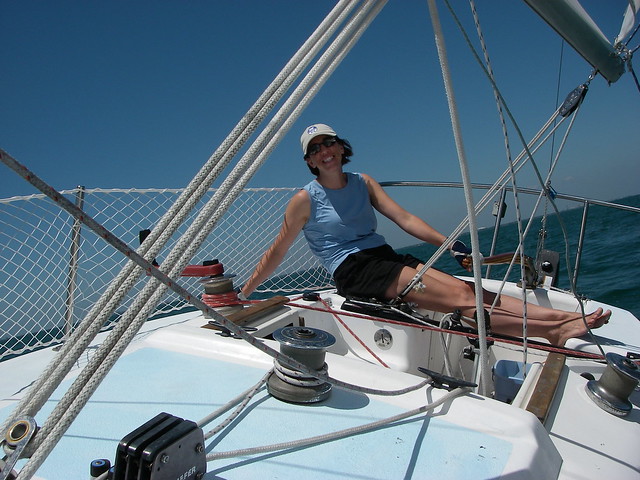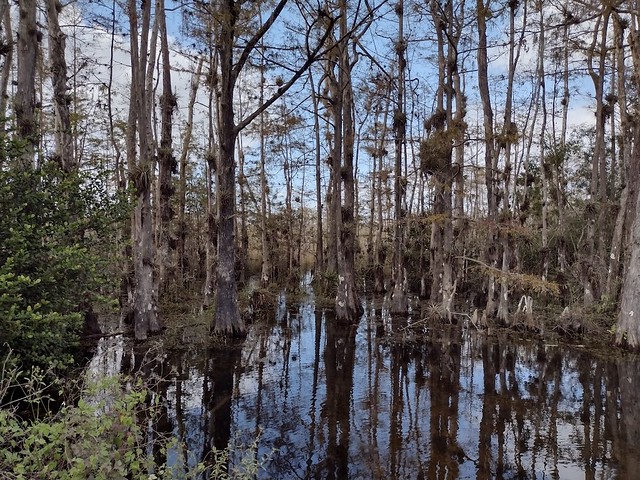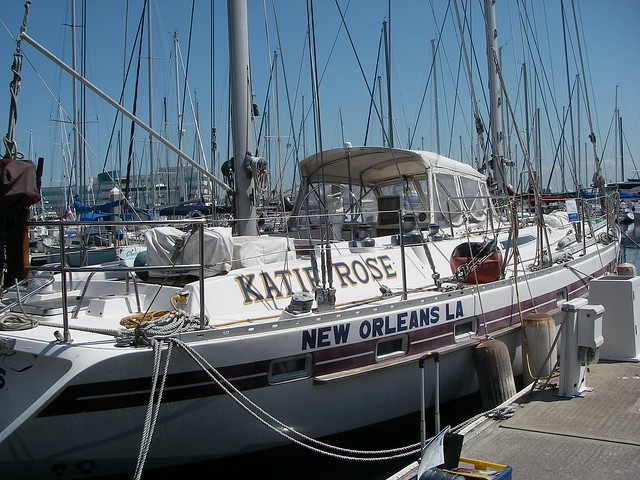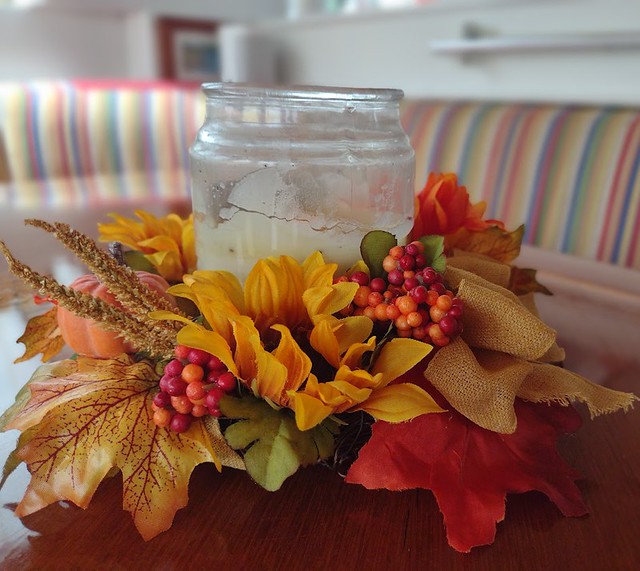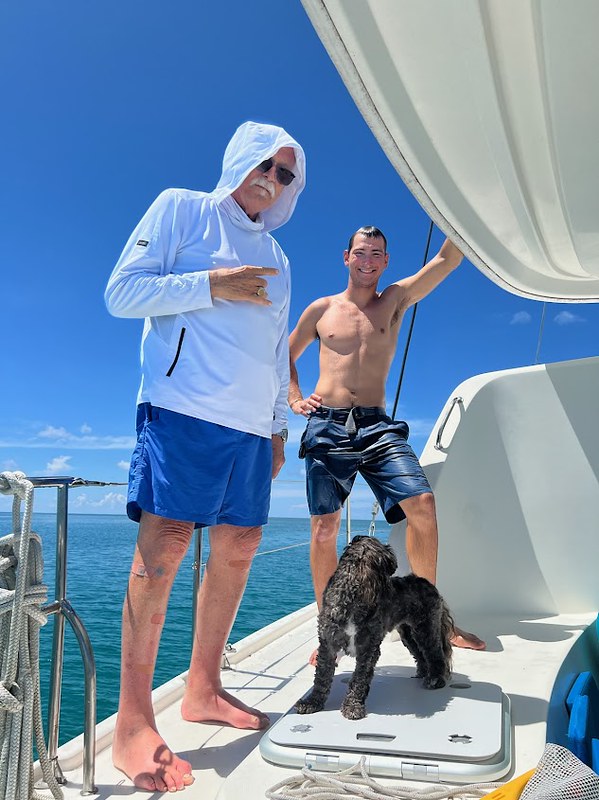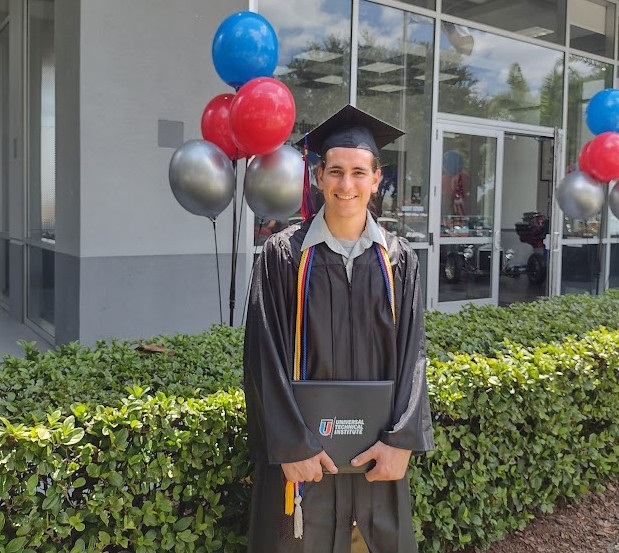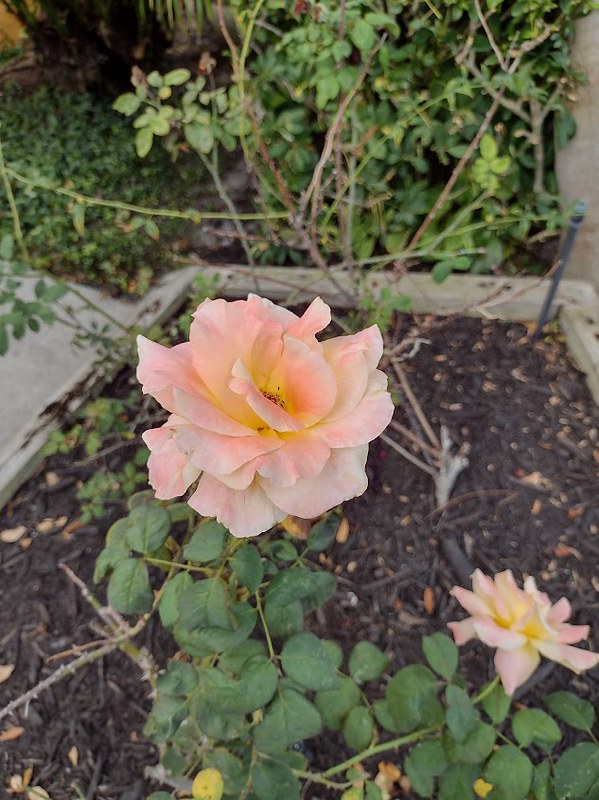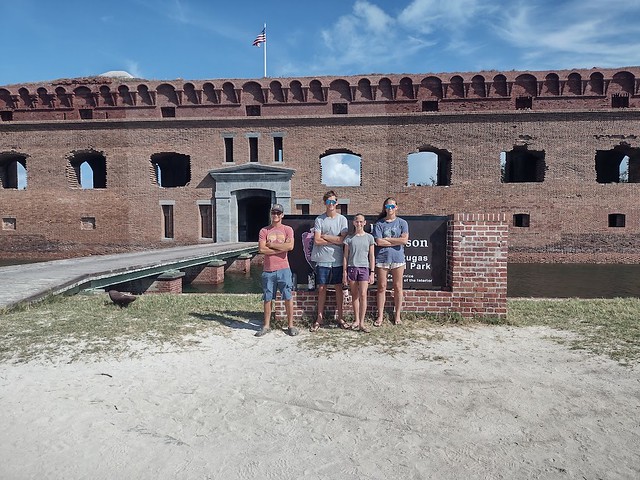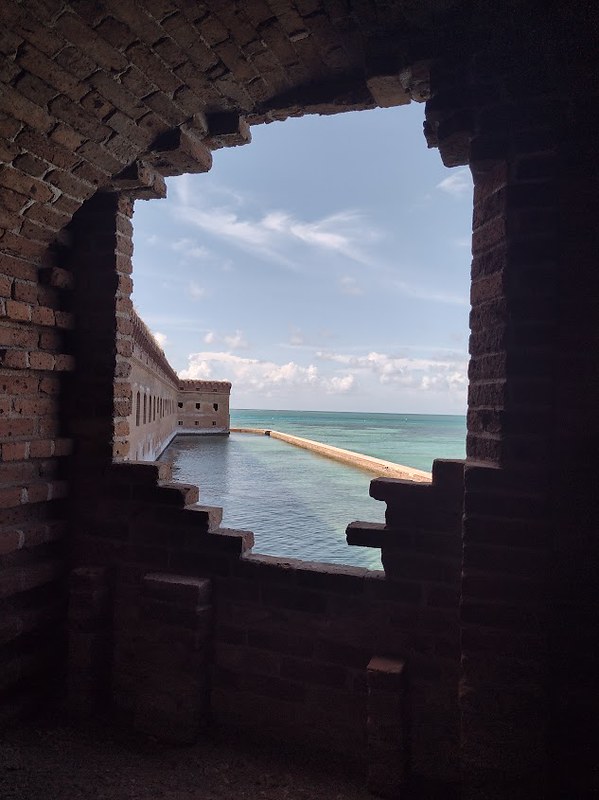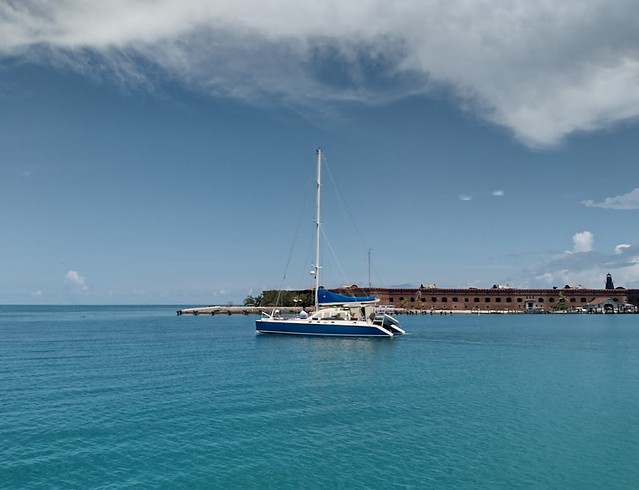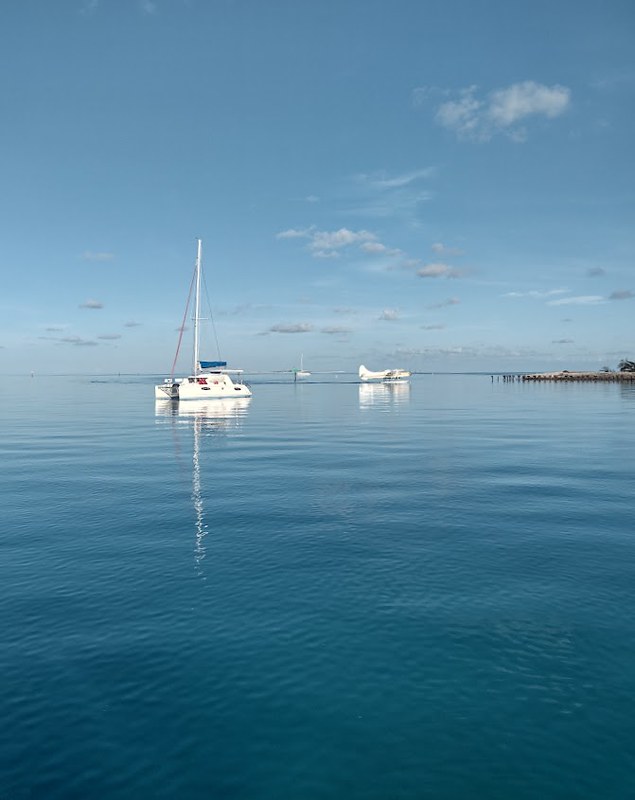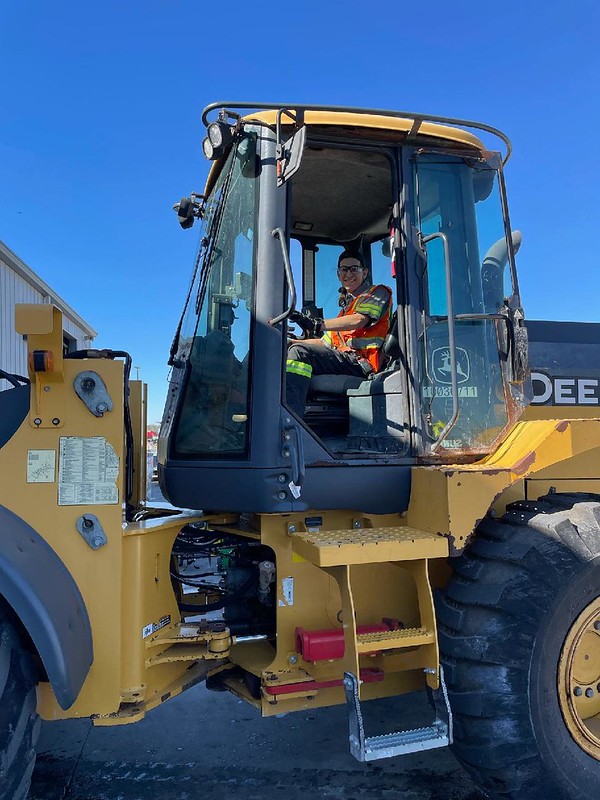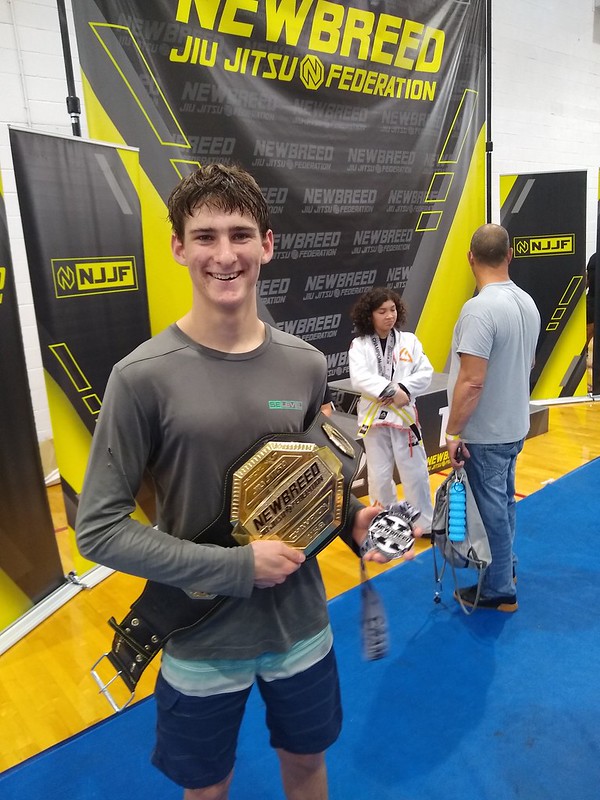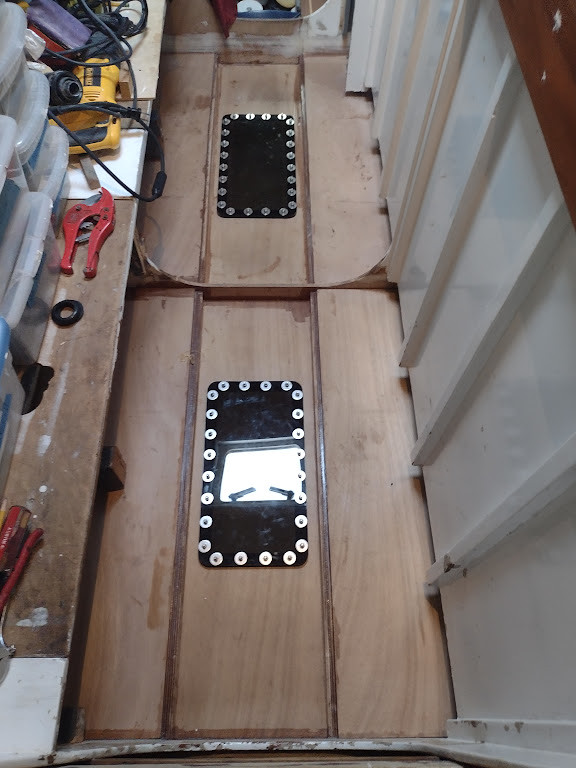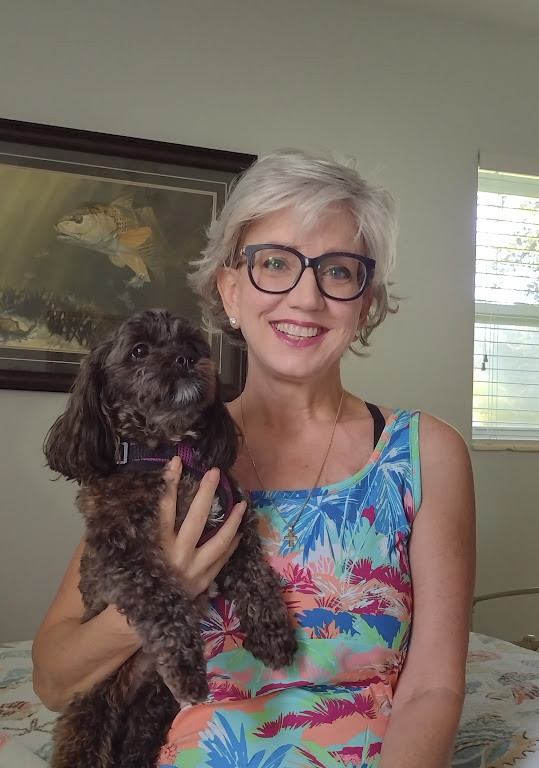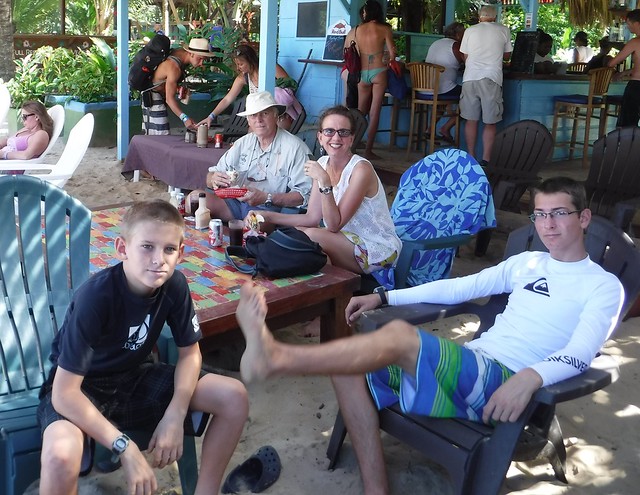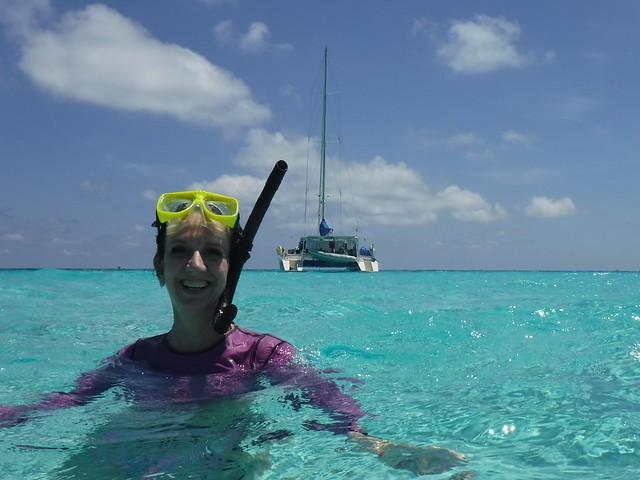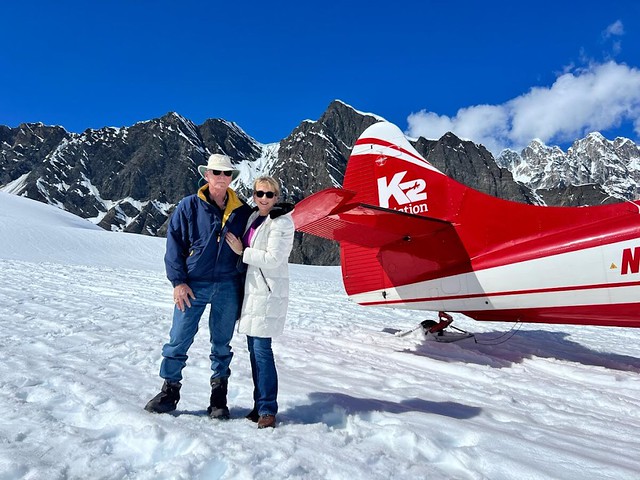*Click on any photo to go to our Flickr account to see more pictures!
Until recently, Take Two has been chock-a-block with our kids and their stuff. When Eli left home, Sam moved out of the cabin he shared with Aaron and took the recently-vacated space. When Aaron left a year later, Rachel moved out of her (tiny) single berth in the port hull and moved into Aaron’s bunk. Sarah left for the Coast Guard six months ago, and Sam just finished repairing, sanding, and painting our first empty cabin on Take Two. The paint was still curing when we took on our first visitors: two of my brother’s ten kids, Tessa (15) and Teresa (13), whom we had invited to join us on a month-long trip to the Bahamas. We thought it would be fun to have cousins as built-in buddies for our kids, and to give my nieces a new adventure.
They packed their bags and joined our crew the third week of April. Eli and Aaron came over for a farewell dinner and we went over the chart and itinerary. We motored out of Port of the Islands marina and through the Ten Thousand Islands the afternoon of the 22nd on a high tide and spent the first day sailing in glorious wind and relatively calm seas. We discovered that Teresa is sensitive to motion, but Tessa is not. We anchored near Cape Sable the first night and motor-sailed around Everglades National Park the next day until we made it to Islamorada (middle-Keys).
We went through the Snake Creek Bridge on the 24th to prepare for our quick haulout/insurance survey the next day in Key Largo. Haulout complete, we went back through the Snake Creek Bridge to hide from strong east wind for a few days on the bayside. We fueled up at Isla Marina, then anchored behind Upper Matecumbe Key, not far from the Lorelei Restaurant in Islamorada.
We waited an unexpectedly long time—two weeks—for a good weather window to cross the Gulf Stream, time we spent acclimating to living off grid with new crew, making and budgeting power and water for four teenagers, figuring out a laundry schedule to wash and hang clothes for six, playing dominoes in the cockpit, celebrating Rachel’s 13th birthday, going for walks to local museums and shops, hanging out with old friends, and swimming off the back of the boat. A pod of dolphins came to visit nearly every day, and the strong breeze kept us cool and bug-free.
Finally, we had a break in the weather, headed back under the Snake Creek Bridge (again!) and made our way east to the Abacos on May 9th. Our sail up the coast and across the Gulf Stream could not have been nicer. We had lovely weather and calm seas, a great beginning to the trip. Sam took a long watch at night and did a great job managing navigation, dodging big ships, and adjusting sails. After waiting so long and enduring unusually strong late-April wind and squalls, we were so happy to be on our way at last!
We checked into West End on May 10th and headed across the Banks. What follows is a log of our travels that Teresa helped put together, and a short essay by Tessa detailing her thoughts about living aboard Take Two for six weeks. Jay and I consider the trip a huge success and can’t wait to “take two” with us again on another adventure!
Ship’s Log, by Teresa
May 10, Little Bahama Bank. We arrived in the Bahamas and checked in at West End. That night we anchored at Mangrove Cay on Little Bahama Bank. That night we saw the Northern Lights.
May 11, Allans-Pensacola Cay. We sailed in the morning toward the Abacos and anchored at Allans-Pensacola. We came ashore by dinghy and explored the island, walking on a trail to the other side.
May 12, Manjack Cay. We sailed to Manjack (a.k.a. Nunjack) Cay and went to the beach, then explored for a bit. We gathered wood for a beach fire, went back to Take Two to make dinner and get S’mores supplies, and then came back for the evening. We saw a SpaceX rocket launch while sitting around our beach fire.
May 13, Manjack Cay. We did school in the morning and went to the beach again in the afternoon and walked to the other side of the island. Aunt Tanya saw a lemon shark.
May 14, Manjack Cay. Rainy Day. Watched movies, baked cookies.
May 15, Great Guana Cay. We motor-sailed around the Whale (Whale Cay) in calm seas and anchored at Guana Cay. That evening, some inexperienced sailors were anchored near us when a squall passed. Their anchor started to drag and they almost hit us, but we got the fenders out in time. (They re-anchored farther away.)
May 16, Great Guana Cay. Thunderstorms all day. We cleaned the boat in the afternoon.
May 17, Fowl Cay and Man O’War Cay. We snorkeled in calm, clear water on the reef at Fowl Cays and then motored to Man O’War to anchor for the night.
May 18, Man O’War Cay and Elbow Cay. We went ashore in the morning to walk around and find groceries. We stopped at a gift shop and a coffee shop. We motored to Elbow Cay (outside Hope Town) and Tessa made buns for burger night.
May 19, Elbow Cay. We snorkeled on Elbow Cay Reef and then did laundry, played games, and swam in the afternoon.
May 20, Elbow Cay. We went to the Elbow Reef Lighthouse with another boat family (aboard S/V Seahawk). We got ice cream at Skoops afterwards. We went to the town beach in the afternoon.
May 21, Elbow Cay. We rented bikes and went for a ride around the island. We stopped for brunch at Oasis café and made it all the way to the other end of Elbow Cay. We came back and had rainbow sherbet at Skoops. We went for a swim at the beach before heading back to the boat. That night, Ted and Gail from S/V Viento Azul and their crew, Jim, Andy and Sadie and their daughter Claire, came over for Taco Tuesday on Take Two. We went for a swim in the full moonlight.
May 22, Elbow Cay. We did school in the morning, and then met another boat family, the Duncans aboard S/V Another Summer, in the afternoon. We went swimming with their three teenagers and played on the floating island of fun and then went to happy hour at Hope Town Inn and Marina for chicken wings and corn hole. Later that night, the Duncans came over for games on Take Two and we watched another rocket launch.
May 23, Elbow Cay. We went to Tahiti Beach, which was a bit disappointing because the water was too warm and there wasn’t much to do. Tanya met up with her old friends Steve and Laura Gallagher then took a long walk on the other side of the island to look for sea glass. The Duncans came to hang out after dinner, and all the kids took the dinghy ashore to watch the rocket launch from the ocean side of the island (to see the booster land).
May 24, Sandy Cay. We left Tahiti beach and motored to Sandy Cay, where we snorkeled in crystal clear water at the Land and Sea Park. We swam with a sea turtle and Tessa saw a shark. We anchored at Lynyard Cay that afternoon.
May 25, Little Harbor and Lynyard Cay. We anchored in the Bight of Old Robinson and the kids took two kayaks to look for blue holes. Afterward, we went to Pete’s Pub for lunch and then went to the beach. We anchored at Lynyard Cay in the afternoon and swam and played on the floating island of fun.
May 26, Northeast Providence Channel. We left Little Harbor at dawn and motored nine hours upwind in choppy seas, with squalls, toward Spanish Wells (bashy and uncomfortable for most of it). We anchored for the night at Meeks Patch.
May 27, Spanish Wells. We rented a golf cart and drove around town, bought souvenirs, and got groceries for the trip home. We returned to the boat in the afternoon and moved to Egg Island to anchor for the night. We went for a sunset snorkel on Egg Reef and saw a little shark.
May 28, Tongue of the Ocean. We motored across the tongue of the Ocean and stopped the boat for a swim in 6000 ft. I (Teresa) burned my hand while making ramen and missed the swim! We anchored at Chub Cay for the night.
May 29, Great Bahama Bank. We motored all day across the banks and put the engines in neutral so we could go for a drift-swim when we got hot. We had two “pet” remoras with us. We played dominoes in the afternoon and crossed the Gulf Stream overnight.
May 30, Gulf Stream, Florida Keys. We crossed to Florida without incident and arrived in the Keys mid-morning. We snorkeled at Hen and Chickens Reef near Plantation Cay and then went under Snake Creek Bridge for the last time. We motored around Everglades National Park. There was an afternoon thunderstorm and a lot of wind. After the storm, we put up the sails and sailed all night.
May 31, Everglades National Park, Ten Thousand Islands, and home to Port of the Islands Marina. We anchored in the Ten Thousand Islands around 3:30 in the morning. We woke up mid-morning and motored into the channel at high tide. We cleaned the boat while Aunt Tanya went to get subs for lunch. We talked about the trip and then Mom came to pick us up to go home.
Boat Life from an Outside Perspective by Tessa
Going to live on a sailboat for a month and a half with my aunt’s family was not on my 2024 BINGO card. My Aunt Tanya brought up the idea on March 7th and by March 12th I had applied for my passport, though that didn’t mean confirmation I was going yet. A couple of days after getting our passports, our parents had okayed the idea. At that point I wasn’t so sure I was ready to leave. I was on the fence, leaning toward the “I’m not going” side. Leaving home and friends for four to six weeks was very daunting. I tend to get homesick and being in another country without girls my own age was not ideal in my book. The 14th of April rolled around and Tanya texted that we would probably be leaving the 17th. It felt too soon and I didn’t feel ready to go, but then the departure date was delayed to the 21st and I was more inclined to go. Finally, the day before, I decided it was a “yes.” I had seen my friends and felt better about the decision. We packed up and left for the boat on the 21st and sailed for the Florida Keys the next morning. We ended up being stuck in the Keys for two weeks because of weather. By the end of the first week, I was giving up hope that we would even make it to the Bahamas. By week two, we saw wind and weather clearing up and on May 9th, we left to cross the Gulf Stream to the Bahamas.
Sailing wasn’t as scary as I thought it would be; I didn’t get sick, and I got my “sea legs” easily. I didn’t really have to adjust to living on the boat—it felt like normal living, but just with a different family. (That might be because our two families are so similar.) Part of living on the boat is being careful with water usage and trash sorting, I felt like I got used to it very quickly and it didn’t feel like a hardship. The wonderful part about being in the Bahamas is you live in an endless swimming pool—the water is so beautiful I can’t even describe it, so clear you can see the ripples in the sandy bottom at a depth of 35 feet. Snorkeling was definitely my favorite: diving down 30 feet to see huge coral structures and dozens of different kinds of fish is one of the most jaw-dropping experiences I’ve ever had. Being on the boat means you get to go to islands not a single other person is inhabiting and seeing scenery you would not otherwise see. One of my favorite parts about the towns in the Bahamas is they’re all walkable or bikeable and we had so many amazing experiences walking around town meeting new people and trying out new things, something I wouldn’t trade for anything. Being in Hope Town felt like the most “normal” part of the trip—going into town, buying groceries, riding bikes, doing regular daily activities, and meeting other people who lived similar lives (living on a boat after having lived on land). We left the Bahamas on May 28th and got back Friday the 31st.
The pros of being on the boat were having a different and unique experience, learning to adapt to a different environment, being in beautiful places out in the wild, and traveling and meeting new people. The cons were being isolated, living without air-conditioning, experiencing discomfort, having to limit water usage, living in very close quarters and sometimes feeling trapped, understanding that weather determines EVERYTHING, and having to improvise when far from civilization. On a scale of 1-10, I would give boat life a 10 for adventure, but a 7 for comfort. I highly recommend the experience, but if I had to live aboard long-term, I would need to be more comfortable. What I appreciate about my land life is not having to be as careful with water, being with my family, and being able to see my friends without being an ocean apart. Would I go again? The answer is yes, but would I live this way permanently? Probably not. Though I had an amazing time and a good experience on the boat, I don’t think I would do it as a lifestyle. Living on land is easier and suits my preferences. I think I would like to go sailing with my aunt and uncle again if they were going to a different country to get a new experience.































